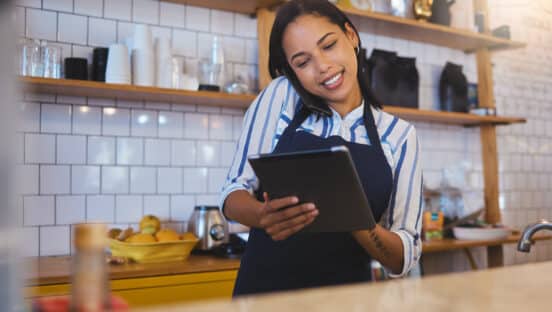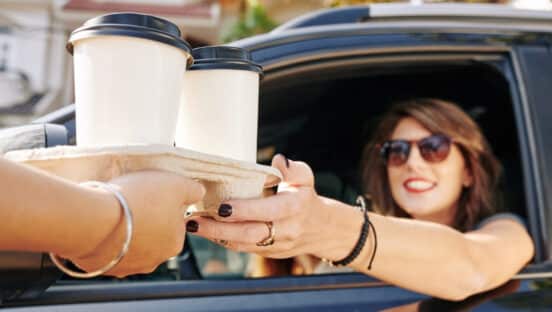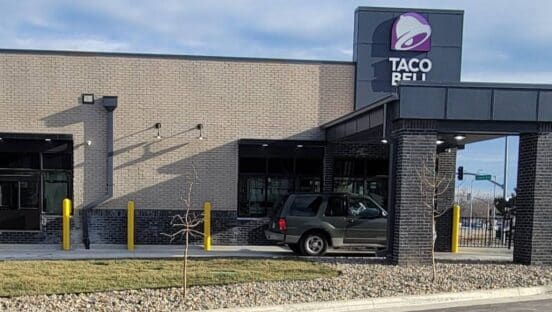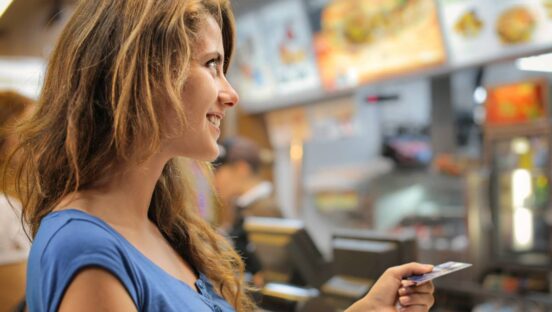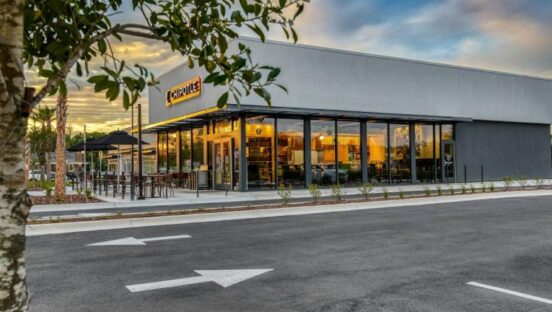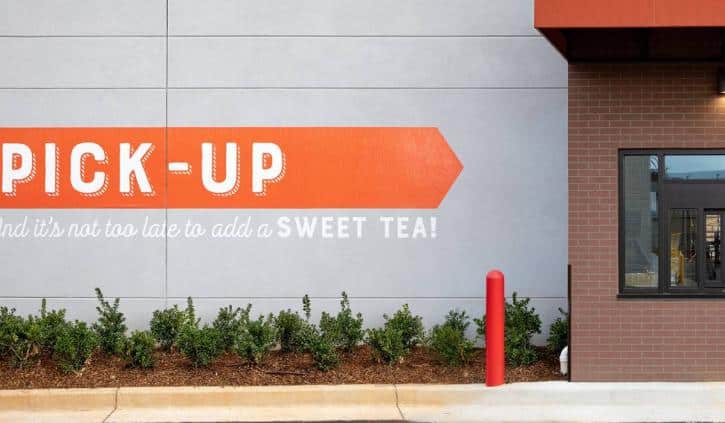
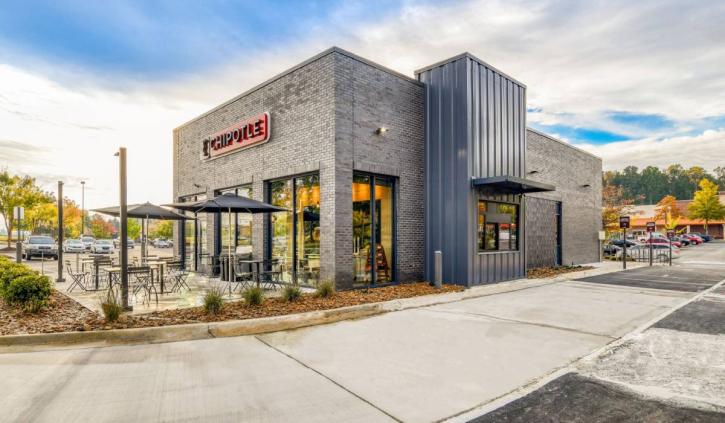
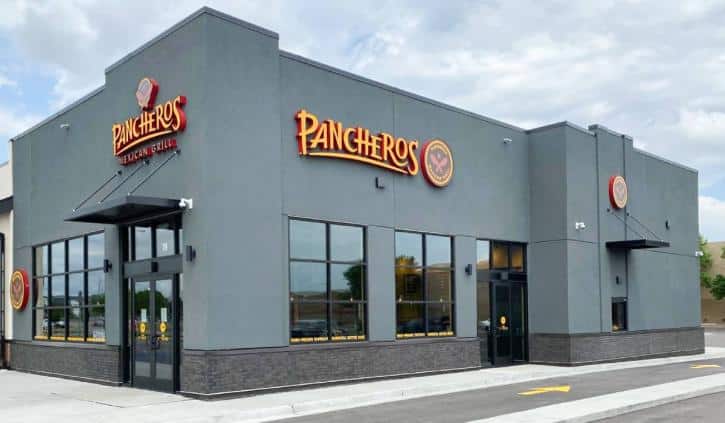
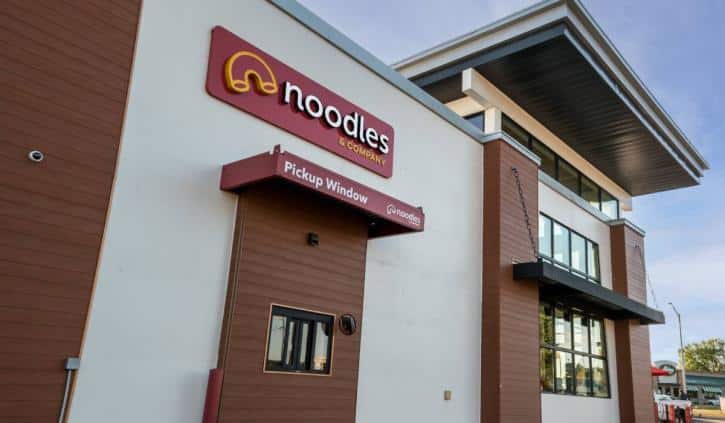
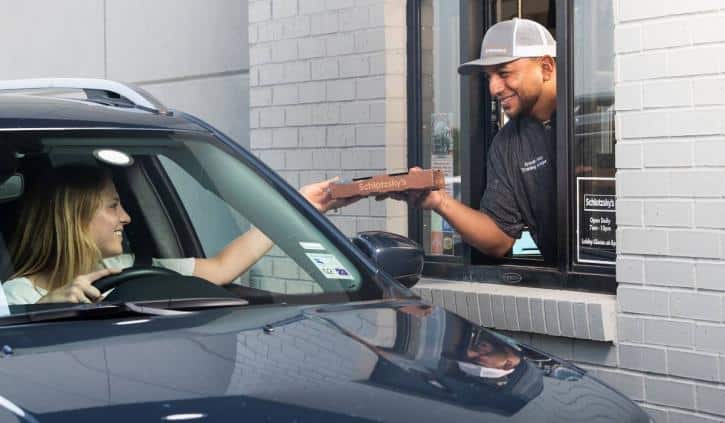
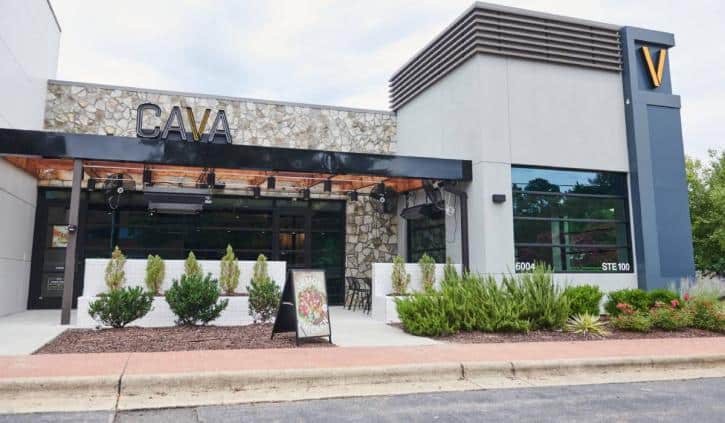
On October 1, 2010, the Midland Reporter-Telegram shared an innocuous 110-word news brief about the debut of a McAlister’s Deli location on Wadley Avenue in Midland, a West Texas town best known for oil and hosting the childhood home of former U.S. President George W. Bush.
The copy introduced the Midland restaurant as a “new model” for the Mississippi-based McAlister’s franchise, featuring a smaller footprint, patio dining, and WiFi, before tucking in one nondescript sentence unknowingly forecasting the future of fast-casual dining.
“The new location also includes a call-ahead window where customers who place call-in orders can pick up their food,” the story read.
Months later, McAlister’s franchisee Richard Osborn spoke about the benefits of having the “call-ahead pick-up window” at the Midland restaurant. Osborn said the window—essentially a drive-thru lane without a speaker system and designed explicitly to accommodate carryout orders—was accounting for 15 percent of the store’s sales and was servicing 75–85 cars during a busy hour, easing congestion in the dining room and heightening convenience for customers.
It was, Osborn concluded, an unquestioned success, so much so he promised any future McAlister’s units built by his Southwest Deli Group would include a pickup window.
READ MORE: Check out QSR’s 2022 Drive-Thru Report
After a dozen years, a global health pandemic, and a technological revolution that sent digital orders at quick-service and fast-casual establishments soaring—thereby replacing the aforementioned phone-in order with a mobile order—one in four McAlister’s Deli locations host a pickup window today. Shelley Harris, senior vice president of operations for McAlister’s parent company Focus Brands, calls the pickup window, “a critical feature” in all new restaurant construction.
“The pickup window is a natural extension of how consumers’ expectations, preferences, and definition of service has evolved,” Harris says, adding that guests’ hunger for convenience expedited the implementation of pickup windows at McAlister’s and its fast-casual peers in the Focus portfolio, which includes Schlotzsky’s, Moe’s Southwest Grill, and Jamba. “The pickup window experience allows guests to engage with our restaurants in a way that can help simplify and streamline their experience.”
While fast casuals once largely shunned drive-thrus, a bold line distinguishing their more polished, sophisticated positioning from traditional fast-food players like McDonald’s or Burger King, the pickup window has emerged a mighty tool in recent years.
Investing heavily in digital ordering technology and seeking to address consumers’ constant hunt for convenience, if not safety in the COVID-19 era, fast casuals from coast to coast have embraced the pickup window (or, alternatively, the pickup lane) to deliver speedy, safe service for the contemporary consumer. In the process, fast casuals have been able to challenge—if not top—the convenience and ease many drive-thru-powered quick-serves have long championed to consumers.
QSR talked with five fast-casual brands about integrating pickup windows into their store design, what the windows provide, and why they are here to stay.
Note: If viewing on desktop, please click the arrows in the picture above to see the next slide.
Chipotle
Providing a more efficient, discrete, and modern experience
To increase access and convenience for guests while also supporting the brand’s rising digital business, it began testing its so-called “Chipotlane” in early 2018, a drive-thru pickup lane designed to accommodate mobile orders from guests wishing to stay in their cars rather than entering the restaurant and plucking their order off the store’s dining room pickup shelves.
A quick success at Chipotle’s Ohio test site, Chipotlanes are now present at more than 400 Chipotle restaurants and quite intentionally not called drive-thrus—a distinction Chipotle chief development officer Tabassum Zalotrawala considers important as some jurisdictions prohibit drive-thrus.
Chipotlanes enhance access, ease, and satisfaction for guests and, as a result, have generated strong results for the brand. In fact, new restaurants featuring a Chipotlane open with about 15 percent higher sales compared to their non-Chipotlane peers launched during the same period, Zalotrawala reports. Yet more, Chipotlane orders represent the brand’s highest-margin transactions.
MORE: Inside the Rise of the Game-Changing ‘Chipotlane’
After finding success with the pickup window in suburban areas, Chipotle re-envisioned the Chipotlane for dense urban areas with high foot traffic and conceptualized a walk-up window where vehicular lanes were not feasible. The brand began testing its first walk-up window near Chicago’s Wrigley Field in late 2019 and now has nearly 20 in operation.
“Chipotlanes are a key growth strategy for the brand and we are building a real estate pipeline that will accelerate new unit growth in the range of 8–10 percent per year, with greater than 80 percent of new restaurants having a Chipotlane,” Zalotrawala says.
This includes the new Chipotlane Digital Kitchen in Cuyahoga Falls, Ohio, a digital-only prototype that serves guests exclusively through a Chipotlane and a walk-up window.
Zalotrawala refers to Chipotlanes as “the digital drive-thru of the future,” a pickup lane eschewing the traditional speaker box, menuboard, excessive signage, and stack of cars to empower a more efficient, discrete, and modern experience. She says the total Chipotlane transaction takes less than 30 seconds.
And Chipotle will continue investigating potential improvements to make things even better for guests, Zalotrawala promises. To reduce friction inside its restaurants and provide a seamless experience with front-of-the-house operations, for instance, Chipotle added digital kitchens, or second make lines, dedicated solely to fulfilling digital orders.
“Chipotle is focused on constant innovation to expand access and deliver exceptional in-restaurant and digital experiences,” Zalotrawala says.
Pancheros
Efficiency and flexibility for on-the-go guests
Pancheros debuted its first pickup window last October in Moline, Illinois, a 40,000-resident city on the Illinois-Iowa border. The pickup window is devoted to fulfilling mobile orders for customers who select “drive-thru pickup” as their order mode on the Pancheros app. The 72-unit chain has since opened a second Pancheros with a pickup window in Bismarck, North Dakota.
Pancheros leveraged its robust loyalty program to notify local customers of the pickup window option, specifically using emails and push notifications. North Dakota-based franchisee Steve Majkrzak calls the pickup window at his Bismarck restaurant an absolute hit, especially during the blustery North Dakota winters.
“With the ease of not having to leave your car in below-zero temperatures, getting the same comforting burrito is a no brainer,” Majkrzak says.
Similar to Chipotle, the Moline and Bismarck Pancheros locations feature a second make line to ensure operations can manage both digital and in-house orders. Pancheros vice president of operations Bill Adams says each store deploys staff to serve either mobile or on-site orders during peak periods, which creates an efficient environment for the restaurant and its guests.
When building future stores, Adams says Pancheros will continue to add mobile pickup windows whenever possible to address guests’ desire for flexibility when ordering.
“The design and layout of the restaurant will be a determining factor if this addition is possible, but we understand the need for convenience is there and want to find a solution to provide that to our guests whenever possible,” he says.
Noodles & Company
Blending digital strength with pickup windows
Quite strategically, Noodles & Company installed its first two Quick Pickup Windows in 2018 in Wisconsin, one of Noodles’ largest markets, to test the concept with guests already familiar with the brand. Once guests order on the Noodles app or website, they then receive an estimated ready time for order pickup at the drive-thru window.
When restaurants had to shut their doors during the COVID-19 pandemic, Noodles chief financial officer Carl Lukach says the value of pickup windows shined. The windows answered guests’ wishes for a safe experience and became especially popular with two of Noodles’ core demographics: families and guests with young children.
“The success of the Quick Pickup Windows during the pandemic influenced Noodles to implement them in new locations,” Lukach says.
After debuting Quick Pickup Windows in Monona and Madison, Wisconsin, 25 additional Noodles restaurants have since added the feature. As the 456-unit company considers new restaurant locations and openings, the ability to incorporate a pickup window looms large in decision-making. The windows combined with Noodles’ digital strength, Lukach says, are vital to meet the needs of today’s fast-casual environment and capitalize on long-term guest trends.
“We plan on prioritizing Quick Pickup Windows at new restaurants moving forward as it strengthens our off-premises capabilities and provides our guests with the utmost convenience,” Lukach says.
Focus Brands
Evaluating execution and evolving
Focus Brands continues to evolve its prototypes and service channels with an eye on creating a simple, efficient guest experience, which includes adding pickup windows to its restaurants and investing heavily in consumer-facing digital technology to capture orders. There is, after all, a symbiotic relationship between the two, Harris notes.
“We have seen that with the addition of pickup windows comes the increase of mobile orders,” she says.
While McAlister’s was the first Focus-owned concept to integrate a pickup window, other fast casuals under the company banner have followed suit, including Schlotzsky’s, which introduced its Design 1000 prototype earlier this year. The Design 1000 features a double drive-thru in which one lane is dedicated to traditional drive-thru orders while a second lane fulfills mobile orders and delivery pickup.
“We have seen that by increasing accessibility and convenience, positive business results can follow,” Harris says.
Through the Schlotzsky’s prototype, Focus will study consumer interaction with the double drive-thru option. Thereafter, the company can parlay those insights into sharpening the offering before employing it elsewhere. It’s a test-and-refine process Focus routinely employs.
McAlister’s, for example, recently added a button to its app allowing mobile order customers to alert restaurant staff they have arrived. The guest then receives a message directing them to pull into the pickup lane.
“That enables the restaurant team to provide an even more customized experience with each guest,” Harris says. “The restaurant team can quickly find their order, greet them by name, and send them on their way.”
For as much attention as simplifying the guest experience receives, Focus Brands also aims to simplify operations for its franchisees. At Moe’s, for instance, a traditional drive-thru has the potential to complicate operations given the menu’s vast customization possibilities. A pickup window for mobile orders, however, solves that potential pain point.
“Our guests expect to have the option to choose exactly what, when, and where they want to eat, so it is our job to make that process as easy as possible to stay top of mind,” Harris says.
With digital orders soaring in the post-pandemic world, Harris foresees brands needing to increasingly streamline guest access to stay competitive, which is why Focus continues investing in technology and its physical environments.
“The concept of pickup windows is here to stay and will only become more important as more and more guests see the value of the order-ahead service model,” Harris says. “Investing in digital and technology while also building and innovating our prototypes gives the savvy consumer more efficient ways to engage with our brands, which we hope keeps them coming back for more.”
CAVA
All about offering choice
In April 2019, CAVA opened its first “digital drive-thru” in Charlotte. A year later, the COVID-19 pandemic accelerated the brand’s investment in and commitment to developing next-generation stores catering to guests’ evolving experiences, which includes offering a pickup window. The 200-unit chain now has 14 digital drive-thru locations in operation.
“And more than 35 percent of our future development pipeline includes digital pickup lanes,” CAVA co-founder and CEO Brett Schulman says.
Like others, CAVA’s pickup-by-car windows are designed exclusively for digital orders placed on the CAVA app or website, and Schulman says the windows put power into the guests’ hands.
“We make it as convenient as possible for our guests to get their CAVA, however and whenever they choose,” says Schulman, adding that his company’s digital drive-thrus carefully and intentionally straddle the traditional drive-thru line by offering familiarity with a modern, digitally enhanced twist.
“It’s absolutely a drive-thru experience,” he says. “However, it’s not an ordering line; it’s a pickup lane for digital orders. The biggest difference is speed of service, without the loss of our warm hospitality. Guests drive through, pick up their order, and carry on.”






